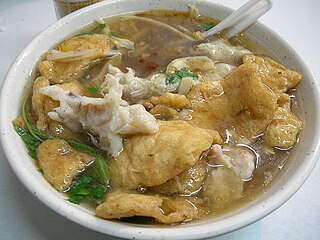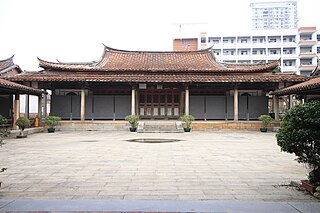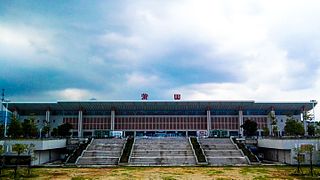
Fujian is a province on the southeastern coast of China. Fujian is bordered by Zhejiang to the north, Jiangxi to the west, Guangdong to the south, and the Taiwan Strait to the east. Its capital is Fuzhou, while its largest city by population is Quanzhou, both located near the coast of the Taiwan Strait in the east of the province.

The Guanghua Temple, also known as the South Mountain Guanghua Temple (南山广寺), is a Buddhist temple located at the foot of Mount Phoenix (凤凰山), about 2 kilometres (1.2 mi) south of Putian City, Fujian Province, People's Republic of China.

Putian or Putien, also known as Puyang (莆阳) and Puxian (莆仙), historically known as Xinghua or Hing Hwa, is a prefecture-level city in eastern Fujian province, China. It borders Fuzhou City to the north, Quanzhou City to the south, and the Taiwan Strait's Xinghai Bay to the east. The Mulan River flows through the southern part of the city.

Fujian cuisine or Fujianese cuisine, also known as Min cuisine, is one of the native Chinese cuisines derived from the native cooking style of China's Fujian Province, most notably from the provincial capital, Fuzhou. "Fujian cuisine" in this article refers to the cuisines of Min Chinese speaking people within Fujian. Other cuisines in Fujian include Hakka cuisine, and the ethnic minority cuisines of the She and Tanka people. Fujian cuisine is known to be light but flavourful, soft, and tender, with particular emphasis on umami taste, known in Chinese cooking as xianwei, as well as retaining the original flavour of the main ingredients instead of masking them.

Puxian, also known as Pu-Xian Chinese, Puxian Min, Xinghua, Henghwa or Hinghwa, is a Sinitic language that forms a branch of Min Chinese. Puxian is a transitional variety of Coastal Min which shares characteristics with both Eastern Min and Southern Min, although it is closer to the latter.

Tegillarca granosa is a species of ark clam known as the blood cockle or blood clam due to the red haemoglobin liquid inside the soft tissues. It is found throughout the Indo-Pacific region from the eastern coast of South Africa northwards and eastwards to Southeast Asia, Australia, Polynesia, and up to northern Japan. It lives mainly in the intertidal zone at one to two metres water depth, burrowed down into sand or mud. Adult size is about 5 to 6 cm long and 4 to 5 cm wide.
The Putian people or Xinghua people, are people from Putian, east Fujian, China. They are also known as Xinghua or Henghua people after the historical name of the area. They speak Min Chinese called Puxian Min.
Hanjiang (help·info) is a district of Putian, Fujian province, People's Republic of China. It ranges in latitude from 25°23' to 25° 27'N and longitude from 119° 04' to 119°10'E. It is located in the middle of the Fujian coast, bordering the Taiwan Strait to the east, south to "triangle of the gold austral Fujian".

Licheng District is an urban district of Putian on the southeast coast of Fujian Province (Minnan), China.

Putian railway station is a railway station located in Putian, Fujian Province, China, on the Fuzhou-Xiamen railway. The station is operated by the Nanchang Railway Bureau, China Railway Corporation. It opened on 26 April 2010.

Sinonovacula is a genus of bivalves.

The Fuzhou–Xiamen railway or Fuxia railway is a dual-track, electrified, higher-speed rail line in eastern China. The line is named after its two terminal cities Fuzhou and Xiamen, both coastal cities in Fujian. The line has a total length of 274.9 kilometres and forms part of China's Hangzhou–Fuzhou–Shenzhen passenger-dedicated railway. Construction began in 2005, and the line entered into operation on April 26, 2010.

Shuitou is a town of Nan'an City, in southern Fujian province, China.
The Fujian Motors Group is based in the Fujian Province, China and was founded in 1992.

Xiangtang–Putian railway or Xiangpu railway, is a Class I higher-speed railway in eastern China linking Nanchang and Fúzhou (福州), the provincial capitals, respectively, of Jiangxi and Fujian Province. The line is named after Xiangtang, a township south of Nanchang, which was originally slated to serve as a terminus, and Putian, on the coast of Fujian, at which the southern branch of the Xiangpu railway terminates. The line actually begins at the Lehua East Station, a rail junction for the Beijing–Kowloon and Nanchang–Jiujiang intercity railways north of Nanchang. The line heads south to Nanchang West Railway Station and bypasses Xiangtang on its way to Fǔzhou (抚州). After entering Fujian, the line forks at Yongtai with the northern fork heading to Fúzhou (福州) and the southern fork going to Putian. The Nanchang to Yongtai section of the line plus the northern fork to Fuzhou is officially named the Nanchang–Fuzhou or Changfu railway. The southern fork is officially named the Yongtai–Putian or Yongpu railway.

The Harmonious Church of the Three-in-One, or Sanyiism and Xiaism, is a Chinese folk religious sect of Confucian character founded in the 16th century by Lin Zhao'en, in Putian. In 2011, it was officially recognised by the government of Fujian.
The common name "Chinese clam" may refer to various bivalves originating from south-eastern Asia, e.g.

Novaculina chinensis is a species of fresh water razor clam in the family Pharidae.

Putian cuisine, also known as Henghwa cuisine or Henghua cuisine, is a style of Chinese cuisine originating from the Putian people of Putian, Fujian Province. It is a style of Fujian cuisine.
The 93rd Division was created in February 1949 under the Regulation of the Redesignations of All Organizations and Units of the Army, issued by Central Military Commission on November 1, 1948,. basing on the 39th Division, 13th Column of the Huadong Field Army. Its history can be traced to the New 7th Division, Jiaodong Military District, formed in August 1947.















